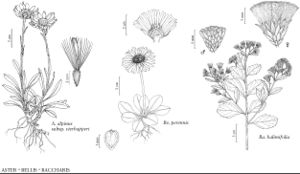Bellis
Sp. Pl. 2: 886. 1753.
Gen. Pl. ed. 5, 378. 1754.
| Taxon | Illustrator ⠉ | |
|---|---|---|
 | Baccharis halimifolia Aster alpinus Bellis perennis | Yevonn Wilson-Ramsey Yevonn Wilson-Ramsey Yevonn Wilson-Ramsey |
Perennials [annuals], 5–20 cm (scapiform; rhizomes herbaceous [roots fibrous]). Stems erect, simple, strigose. Leaves basal (mostly) [sometimes cauline, reduced]; alternate; petiolate; blades 1-nerved, obovate-spatulate to rounded, margins crenate-serrate, strigose. Heads radiate, borne singly. Involucres hemispheric, [3–] 4–6 [–8] × 9–13 mm. Phyllaries 13–14+ in (1–) 2 (–3) series 1-nerved, oblong, subequal, herbaceous, margins entire, abaxial faces strigose. Receptacles conic [hemispheric or nearly flat] (± elongating with age), pitted, epaleate. Ray-florets 35–90 (in [1–] 3–4 series), pistillate, fertile; corollas abaxially often pink or purplish-tinged, adaxially white (closing at night). Disc-florets 60–80+, bisexual, fertile; corollas pale-yellow, tubes much shorter than funnelform [tubular] throats, lobes 5, erect or incurved, deltate; style-branch appendages deltate. Cypselae obconic, compressed, marginally 2-ribbed, eglandular [gland-dotted (sessile)], faces short-strigose [glabrous or ciliate-margined]; pappi 0 [bristles]. x = 9.
Distribution
Introduced; North America, Mediterranean basin, Europe, n Africa, Macaronesia, also to temperate areas worldwide
Discussion
Species 15 (1 in the flora).
O. Fiz et al. (2002) showed that Bellis is closely related to Bellium Linnaeus and Bellidiastrum michelii Cassini (syn. Aster bellidiastrum Scopoli). Subtribe Bellidinae (Cassini ex D. Don) Bentham should be expanded to include the latter in a group of scapiform perennials or annuals. Fiz et al. showed also that Crinitaria and Galatella (two segregates of Aster in the broad sense complex) are sister to Bellidinae. Exact relationships of this group to other subtribes of Astereae are still undetermined.
Selected References
None.